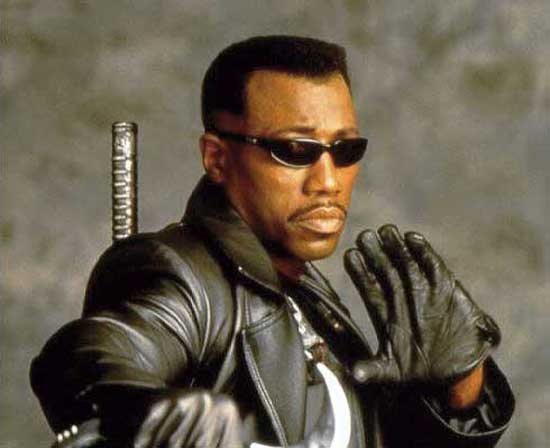 Weird Stuff
Weird Stuff  Weird Stuff
Weird Stuff  Our World
Our World 10 Ways Your Christmas Tree Is More Lit Than You Think
 Movies and TV
Movies and TV The 10 Coolest Stars to Set Sail on The Love Boat
 History
History 10 Things You Didn’t Know About the American National Anthem
 Technology
Technology Top 10 Everyday Tech Buzzwords That Hide a Darker Past
 Humans
Humans 10 Everyday Human Behaviors That Are Actually Survival Instincts
 Animals
Animals 10 Animals That Humiliated and Harmed Historical Leaders
 History
History 10 Most Influential Protests in Modern History
 Creepy
Creepy 10 More Representations of Death from Myth, Legend, and Folktale
 Technology
Technology 10 Scientific Breakthroughs of 2025 That’ll Change Everything
 Weird Stuff
Weird Stuff Ten Bizarre Facts About The Doge Meme
 Our World
Our World 10 Ways Your Christmas Tree Is More Lit Than You Think
 Movies and TV
Movies and TV The 10 Coolest Stars to Set Sail on The Love Boat
Who's Behind Listverse?

Jamie Frater
Head Editor
Jamie founded Listverse due to an insatiable desire to share fascinating, obscure, and bizarre facts. He has been a guest speaker on numerous national radio and television stations and is a five time published author.
More About Us History
History 10 Things You Didn’t Know About the American National Anthem
 Technology
Technology Top 10 Everyday Tech Buzzwords That Hide a Darker Past
 Humans
Humans 10 Everyday Human Behaviors That Are Actually Survival Instincts
 Animals
Animals 10 Animals That Humiliated and Harmed Historical Leaders
 History
History 10 Most Influential Protests in Modern History
 Creepy
Creepy 10 More Representations of Death from Myth, Legend, and Folktale
 Technology
Technology 10 Scientific Breakthroughs of 2025 That’ll Change Everything
Top 10 Martial Artists of Western Film
Here, for your viewing enjoyment, are the ten most buttkicking martial artists in Western films. Eastern films have been left off the list, because the lister is not an expert on them. All the entrants on this list are legitimate martial artists, but they are ranked according to their on-screen prowess and influence.
Speakman is not a very good actor, and that will be something of a mantra throughout this list, but then, martial artists look for excuses to exploit their skills, and they find it in films like The Perfect Weapon and The Expert, and thus, martial arts is an exploitative film genre. You don’t go see one of these films hoping for Daniel Day-Lewis’s level of acting (or else you deserve to be disappointed).
Speakman had his moment of glory in the early ’90s, in the above-mentioned films and a few others. He showcases his expertise in American Kenpo Karate, which is not the sort of karate you often see in films. It stresses an equality of speed with power, namely that the practitioner become fluent in both. Speakman is, in real life, an 8th degree black belt (called Dan ranking) in Kenpo, and does all his own fighting in The Perfect Weapon.
Were it not for the film rarity of Kenpo, he wouldn’t have made the list, because his acting and the writing are almost immorally simple: Jeff plays a karate loner named Jeff, whose sensei is killed by a karate gang. Now Jeff’s gotta do what a man’s gotta do, whoop untold buckets of ass all over Los Angeles. As is typical with martial arts films, the fight scenes provide the entertainment that the acting and writing miss.
A hard-boiled, bald kickboxer somewhat sums him up, but he’s actually quite the actor, and doesn’t only star in martial arts films. Nevertheless, he is about the equivalent of a 2nd dan in kickboxing, and very well trained in Wing Chun and Brazilian Jiu-jitsu. As a result, he is able to do almost all of his own fighting and stunts in his major martial arts films to date: The Transporter series, War and The Expendables. You may ask why he doesn’t try Shakespeare, given that he’s from England, and certainly has the patriotism to try it. Well, fighting is easier and more lucrative.

Unfortunately all clips relating to Wesley Snipes in Blade have embedding disabled – you can view one here. A very good actor, known for the martial arts genre, as well as many other accomplishments. He has a legitimate 5th dan in Shotokan karate, and a 2nd in Hapkido, and he has used his skills to great effect as Blade, the daywalking vampire who hunts and kills vampires. The fights in these 3 films are, at times, outstanding, especially the edge-of-your-seat aggression of his fight with Nomak the Reaper at the end of Blade 2. It was choreographed by Donnie Yen, who has a minor role in the film. Fast-paced, extraordinarily brutal, and not too over-the-top make it an instant classic.
For God’s sake, leave his elephants alone. The guy’s got a thing for elephants. An instant sensation with the film Ong-Bak: The Thai Warrior. His village’s Buddha statue is robbed of its head, and it’s up to Jaa to track it down, trying his best (and failing miserably) to stay out of fights along the way. The style he uses is Muay Boran, the ancestor of Muay Thai. Hard hitting elbows and knees to the top of the head. There aren’t many people left to beat up by the end. He even throws his trademark flying knees while his legs are on fire. Jaa has been estimated by some critics as a 4th dan in Muay Thai, if there were such ranks in the art. Never minding the rank, he is certainly a master of Muay Thai.
In The Protector he plays Kham, a protector of elephants. The elephants are stolen, and Kham breaks nearly every bone in Australia trying to get them back. He finally goes up against three gigantic wrestlers, and the fight is especially entertaining, since he comes very close to losing and has to rethink his approach.
He is a 5-time Chinese National Wushu champion, but let’s clear up just what modern wushu is. The word is Chinese for “martial art,” and any such art, therefore, qualifies as an example of wushu. Modern wushu is a combination of various martial arts, organized into an aesthetic sport of form demonstrations, much like kata floor routines.
Jet Li is acknowledged as a black belt-equivalent master of several Chinese martial arts, including Changquan and Fanziquan (Long Fist and Tumbling Fist). His breakout role in America was as the formidable villain to Danny Glover and Mel Gibson’s heroes in Lethal Weapon 4. He takes them both on, simultaneously, at the end. But his best fight scene, by far, is in Fist of Legend, versus Billy Chau, a real world kickboxing champion. It’s brutal, exhaustive and worth multiple viewings.
He has not yet declared his dan rank in Shotokan, but he is a black belt. He is also well trained in Taekwondo and kickboxing, and fought for real in karate and kickboxing matches and tournaments, amassing a record of 20 wins (all knockouts) to 2 losses. He has made quite a lion’s share of rotten movies, most notably Street Fighter (movies based on video games almost never turn out well). He portrays Colonel Guile, and if it weren’t for him actually throwing Guile’s signature video-game kick, a backflip, double-heel kick to the chin, no one would care at all about the film. What was Raul Julia thinking?
But he’s made some good ones. Bloodsport and Kickboxer are great, campy fun because of his hilarious French accent, but the fight scenes are routinely quite good. He hit his peak with Timecop in 1994, but was strung out on $10,000 of cocaine a week at the time. He has cleaned up and his career seems to be restarting ever since JCVD, a very good and funny spoof of himself. His acting in it is superb. Van Damme is the man with the legendary “helicopter roundhouse kick,” in which he leaps, spins and flings an outside crescent kick to his opponent’s head. Coupled with his ability to do full splits, this one move has cemented his legacy throughout a number of cult classics (almost all of them flopped).
Another lousy actor. If the expression requires a slightly smiling stone face, be it sadness, anger, remorse, contemplation, etc., Seagal’s your man. But bad acting aside, the man does know how to kick ass legitimately. He has a 7th dan in Aikido, and that was, until the late 80s and early 90s, a style the film genre had almost never seen.
Seagal vamped it up into a body-hurling, wrist-snapping extravaganza in Above the Law, his breakout role. The joke goes that it can’t be a Seagal film without a preposition in the title. He followed his success with Hard to Kill, Marked for Death and Out for Justice (the last by far his most violent), and peaked with Under Siege, a superb action thriller with Tommy Lee Jones out-acting absolutely everyone as the bad guy.
He and Seagal get into a memorable Sayoc Kali knifefight at the end, with Seagal patenting his infamous thumb into the eye socket (he’d done the same thing doubly to “Screwface,” the villain in Marked for Death). When it comes to martial arts, Seagal doesn’t just defeat the criminals, he puts them through Aikido Hell. You actually feel bad for them. He’s been making a slew of direct-to-video films, so badly edited and dubbed that no one thinks much of him anymore. Rumors also abound that he’s the biggest jerk Buddhism ever had. But he must know something about front kicks, because he’s currently training with Anderson Silva and Kyoto Machida, and they’ve both won recent MMA fights with the Crane Technique. “If do right, no can defense.”
Probably the second greatest martial arts innovator in film history (#1 is the other). Chan is heavily influenced, not just by other martial arts and artists, but silent film comedians, like Charlie Chaplin and Buster Keaton. Chan loves to make use of props in his fight scenes, to add some humor and more entertainment to the heart-stopping Kung Fu he employs. He hasn’t said whether he has a black belt or the equivalent technique in Kung Fu, but he studied it hard and heavy for his entire childhood and teen years in the Hong Kong Opera School, where he was classmates with Sammo Hung (a great actor in his own right, but not very famous in the West).
His breakout film in the Western Hemisphere was Rumble in the Bronx, which was shot, very obviously, in Vancouver. Its storyline is much the same as that of a film of #1: Chan travels from Kong Kong to New York to help out at the storefront of some cousins, only to run afoul of a vicious streetgang. They picked the wrong Asian to aggravate. Chan always performs his own stunts, no matter how ridiculously death-defying, until recently with the aid of special effects. He claims that special effects, if used wisely, can make the action that much better. Not many agree with this statement, and his old-school action setpieces are beyond belief, especially his astounding work in The Legend of Drunken Master.
The final scene in this film was an entry in another list on Listverse, so why not take a look at an earlier scene in the film, in which Jackie takes on 5 bad guys at once, while his stepmom throws him liquor bottle after liquor bottle. He just gets better and faster, and the use of props and Kung Fu mastery are out of this world.
He cannot purchase insurance from anyone for a film production, because he routinely slides down the outsides of skyscrapers, jumps off moving buses onto other moving buses……we could go on forever. He claims to have broken, at least once, about half the bones in his body, including his skull in Armour of God, nearly skewering his brain with the bone fragment.
No, as a matter of fact, he’s not the #1 entry on this list, although he probably concurs. A famously nice guy in real life, on screen, Chuck Norris is the baddest man in the history of ever. Forget all those Matrix movies. Here’s a guy who actually gets beat up in some of his fights, but always gets back up and kicks the everloving tar out every living thing that moves. And the fight scenes aren’t like a dance. They’re dirty and brutal, and never last very long.
Norris’s resume is stellar, to understate it: 10th dans in two different styles, Tang Soo Do and Shito-ryu Karate, and an 8th dan grandmaster in Tawkwondo. He has founded his own style, Chun Kuk Do, in which he has blended every useful move from all the disciplines he has sampled over the years. He is the only 11th dan in it, and thus the only person who can promote anyone to 10th dan. He also has master instructor status in Jeet Kune Do, and according to his primary instructor, Dan Inosanto, he is the rough equivalent to a 9th dan in expertise in it. He also has a 2nd dan in Brazilian Jiu-jitsu.
So what does it look like on screen? Unbridled power, and quite the actor in some of his films. It’s his raw, powerful presence that nets him 2nd place on this list, and his fight with the late, great David Carradine, in Lone Wolf McQuade, is one for the ages. He comes at Carradine with raw Karate, and Carradine starts to gain the upper hand with Praying Mantis Kung Fu, until he backhands Norris’s daughter. The rest is just breathtaking sweat, growls and pain.
The man who revolutionized not just the martial arts film genre, but martial arts themselves. He is considered by many experts, including Chuck Norris and various professional fighters, to be the father of Mixed Martial Arts. His idea was that, in a real fight, all the memorized stances and forms in the world wouldn’t do you a bit of good if the other guy just charges in full rage. Anger actually does help win a fight, if the other guy isn’t ready for it. Lee’s principle was to train to be ready for anything.
He reached the forefront with a high-level mastery of Wing Chun Kung Fu, under the legendary Yip Man. In the late 50s and early 60s, he fought a number of unofficial professional fights against boxers and other martial artists, and won them all without any difficulty. He knocked out a 6th dan Karate master named Uechi in 11 seconds.
He got into films via The Green Hornet, in 1966, but American audiences were racist and wouldn’t accept him as a star, taking his own pet project, Kung Fu, away from him and giving it to David Carradine, a white man. Lee left for Hong Kong, where he figured he’d get a fairer shake, and proceeded to make only 5 films, before his untimely death at the age of 32. These 5 films remain titans of martial arts cinema, primarily because his acting prowess is outstanding in them, and because they have very good storylines, written primarily by Lee. The greatest of them is Enter the Dragon, his last complete work. He plays an undercover Shaolin Kung Fu master and detective, sent to an exotic island to investigate an opium lord. Meanwhile, Lee masquerades as a tournament participant, and proceeds to best everyone, notably Bob Wall, who plays Oharra, the opium lord’s main bodyguard. Lee’s immortal, running thrust kick into Wall’s chest at the end of the fight actually crushed Wall’s sternum and broke the arms of two extras Wall reeled into.
Lee’s best fight, though, by far, in this lister’s opinion, is his gladiator duel to the death with Chuck Norris himself, in the Rome Colosseum, at the end of Return of the Dragon. Lee and Norris had been friends and training partners since 1964 when they met at a Karate tournament. Norris is on record that Lee, as a Wing Chun expert, didn’t like the idea of kicking anywhere above the waist, since it throws the kicker off balance and takes too long. Norris showed him how to do high kicking the Tang Soo Do way, and Lee practiced with him 4 and 5 hours a day until he was able to kick like Chuck. He, in turn, taught Chuck the Wing Chun “sticky hands” concept.
Their fight in the Colosseum is one for the ages, and today’s modern martial arts fight scenes almost never compare. Norris was World Middleweight Champion at the time, and Lee is genuinely sorry to have to kill his character, Colt, at the end. Lee was by far the fastest martial artist in film history. They had to slow down his fight scenes in places, in order for the audience to see what he was doing. Martial arts fight scenes are typically sped up to enhance them.








